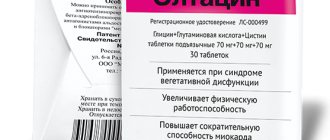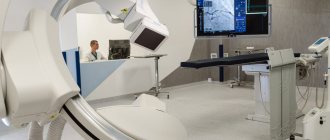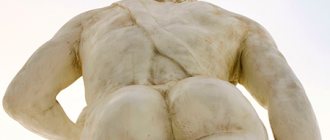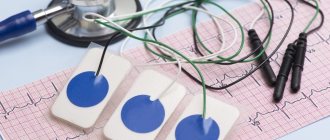Frequent manifestations of VSD (vegetative-vascular dysfunction) are vegetative crises and panic attacks. They usually occur suddenly, during sleep or when a person wakes up. The patient experiences symptoms that interfere with his quality of life. To relieve them, doctors at the Yusupov Hospital use modern medications and non-drug therapy methods. After emergency care is provided, the cause of the disease is determined and planned therapy is carried out.
Drugs and their doses are selected individually for each patient. Psychotherapists use psychotherapy techniques that help prevent panic attacks. Medical staff respects the physical and mental health problems of patients.
Panic attack. What it is? Symptoms of a panic attack
A panic attack is a condition associated with the sudden release of a huge amount of adrenaline into the blood. Adrenaline is a stimulant and prepares the body for a physical response to danger (fight or flight). Hence the characteristic changes in the functioning of the heart and blood vessels, respiratory organs, heat exchange, and kidneys.
Characteristic symptoms of a panic attack:
- Increased heart rate;
- Feeling of fear;
- Lump in the chest, possible difficulty breathing;
- Violation of thermoregulation (feeling hot or cold);
- Vascular spasm (pallor or marbling of the skin, pulsation in the head, etc.);
- Shiver;
- Large amounts of urine may be leaked.
These symptoms themselves are a source of stress and can trigger a second and third wave of panic attacks. Therefore, we will teach you how to remove an attack when it appears. Panic attacks, for all their unpleasant symptoms, can be successfully treated.
Similar symptoms are possible with heart problems , which can be excluded using Holter monitoring, Echo-CG, ECG with stress.
A suppressed response to stress is the cause of panic attacks.
Diagnosis of vascular crisis
If any of the above symptoms appear, it is important to consult a doctor for a thorough examination. During the initial examination, the doctor collects and studies the medical history in detail, asks about when the negative symptoms appeared, how long they lasted, and whether his closest relatives had similar ones. The patient's blood pressure is measured. If he experiences frequent surges in blood pressure, it is recommended to keep and have with him a diary with these indicators.
Diagnosis of vascular crises consists of checking for signs of acute disturbance of general or regional hemodynamics. The diagnosis is made only after excluding the connection of the signs with organic pathology of the heart or blood vessels. In the case of cerebral vascular crisis, it is necessary to exclude hemorrhagic and ischemic strokes. In the case of hypertensive cardiac crisis, exclude myocardial infarction.
Laboratory diagnosis is usually not required. Testing is prescribed if an inflammatory process, diabetes mellitus or other serious pathology is suspected. In such a situation, the patient is prescribed a general and biochemical blood test. Changes in laboratory parameters can reflect the course of pathology, which acts as the main factor in the development of hypertension or other concomitant disease. Among the instrumental diagnostic methods the following may be prescribed:
- electrocardiography. This is an accessible technique that does not require additional preparation. Its peculiarity is the recording of electrical potentials of a muscle organ, which makes it possible to detect changes in rhythm, electrolyte deficiency and other initial symptoms of vascular diseases;
- ultrasound examination of the heart. Using ultrasound, specialists can visually determine contractions of the heart muscle, diagnose heart failure and other vascular pathologies, the symptoms of which are similar to vascular crisis;
- magnetic resonance imaging of the brain. This study is safe for the body because it does not involve exposure to radiation. MRI makes it possible to detect the lumen and patency of large vessels, various anomalies of vascular development;
- echocardiography. Along with an ECG, specialists may prescribe an echocardiogram to get a complete picture. This technique is characterized by high accuracy; it makes it possible to assess the condition of the muscular organ and determine the size of the valves;
- Doppler ultrasound. Often, patients are prescribed Doppler of the cervical spine and head vessels. This is a highly informative and safe examination that allows you to detect various vascular pathologies. There are no contraindications to Doppler ultrasound and it is not accompanied by side effects. Dopplerography includes ultrasound examination of the carotid arteries, vertebral arteries and main arteries of the brain. This diagnosis is especially important for regular dizziness, loss of space, the appearance of “floaters” before the eyes and other similar symptoms of vascular crisis. With its help, specialists evaluate blood flow in the vessels of the head.
Sympathoadrenal crisis or panic attack? Causes
There are three main types of sympathoadrenal crises:
- A panic attack is a “bombardment” of adrenaline against a background of suppressed anxiety. This is typical for people prone to the accumulation of nervous tension. When emotions that have not found realization and resolution “overflow,” the body prepares for a physical response to danger and you feel it as a panic attack.
- Sympathoadrenal crisis due to adrenal adenoma. In this case, in one of the adrenal glands there is a small benign tumor (adenoma), consisting of cells that produce adrenaline in excess. This is not difficult to establish with an ultrasound or MRI of the adrenal glands.
- Vegetative epileptic seizure. In this case, the attack is triggered by a pathological epileptic discharge emanating from the neuron cells of the autonomic nervous system. to establish a connection between a panic attack and epileptic brain activity using an EEG.
The symptoms of panic attacks and sympathoadrenal crises in adenomas are very similar to each other, and their treatment is different. Adrenal adenomas are dangerous and must be removed.
People with high willpower are susceptible to panic attacks , who can force themselves to work “even though I can’t” and hide negative emotions. Emotions that are not fully experienced and not resolved are repressed and forgotten. After some time (from days to tens of years), the accumulated excitement finds release in the form of a panic attack.
Consequences and forecasts
If attacks of a vegetative crisis are not stopped in a timely manner, the consequences can be very disastrous and severe. The patient’s memory records the experienced attack for a long time, and the person begins to fear a repetition (the so-called “expectation syndrome”). The patient begins to avoid places that are potentially dangerous for himself, and those situations that are fraught with an attack. This leads to changes in his behavior, mental disorders, and the formation of phobias. If a person asks for help in time, the forecasts are very positive. Competent and adequate treatment of a vegetative crisis will prevent recurrence of attacks, and, consequently, the onset of serious consequences.
Primary appointment with a neurologist: 1850 RUR.
Sign up Online 5% discount when registering from the site
Treatment of panic attacks: medications
Medications do not treat the causes of panic attacks, but they can reduce or temporarily eliminate their symptoms. The following groups of drugs are mainly used:
- Beta-blockers (anaprilin, atenolol, etc.). Beta blockers partially block the effect of adrenaline on the body; they can be used to relieve or prevent a panic attack.
- Tranquilizers (phenazepam, alprazolam, etc.). Tranquilizers reduce the excitability of the central nervous system and thus interrupt a panic attack.
Tranquilizers can also be used to prevent panic attacks. Tranquilizers quickly relieve the symptoms of panic attacks, but do not treat their causes, which often forces patients to take tranquilizers for years, with resulting drug dependence and decreased ability to think. We prescribe tranquilizers only for the first time , until the causes of panic attacks are eliminated.
Antidepressants - SSRIs (selective serotonin reuptake inhibitors - Cipralex, Paxil, etc.). As a result of long-term (6-12 months) use of SSRIs, panic attacks usually stop. After discontinuation of SSRIs, a recurrence of panic attacks is possible if their psychological background remains. To avoid long-term medication use and recurrence of panic attacks after withdrawal, we will suggest you work through the psychological component of panic attacks with a professional psychotherapist.
We will help you resolve all issues of medicinal and psychotherapeutic treatment of panic attacks.
Diagnosis and treatment
Diagnosing a vegetative crisis in modern medicine does not pose any particular difficulties. The most important thing is to exclude serious mental, somatic or endocrine diseases.
There are three diagnostic criteria for a vegetative crisis:
- Time limitation and paroxysmal nature
- Presence of multisystem disorders of the autonomic system
- Presence of states of emotional and affective nature
Modern medicine uses a variety of measures to treat vegetative crisis: psychotherapeutic, pharmacological and psychosocial. The best and most effective way to treat this disease is considered to be taking psychotropic medications coupled with psychotherapy sessions.
Treatment of panic attacks: psychotherapy
Psychotherapy is the only way to get rid of panic attacks once and for all. Moreover, in contrast to popular belief, a psychotherapist will not “talk and calm you down,” but, on the contrary, through energetic psychotherapeutic work together with you, he will lure you out of the depths of the unconscious and resolve the cause of panic attacks. We use several psychotherapy techniques to treat panic attacks. Taking into account the patient’s condition and wishes, therapy is proposed that brings the fastest and most complete results. After 1-2 months of therapy, our patients usually feel absolutely normal.
Classification
Vegetative crisis does not have a single classification. It is usually divided into types, which have varying degrees of severity and symptoms, which in turn are related to blood pressure readings and the functioning of the cardiovascular system.
Vegetative crisis is divided into several types with varying degrees of severity. The lung is characterized by short attacks of 10-15 minutes, with pronounced disorders of the autonomic system and manifestations of a monosymptomatic nature, with no post-crisis asthenia. Attacks of moderate severity can last from 15-20 minutes to an hour, while there are polysymptomatic manifestations and post-crisis asthenia, which last for 24-36 hours. During a severe attack, a combination of polysymptomatic crises is observed along with convulsions and hyperkinesis; this condition lasts more than one hour and is accompanied by multi-day asthenia.
Based on symptoms, vegetative crisis is divided into: vagoinsular, sympathoadrenal and mixed.
Panic attacks. Treatment. Routine, nutrition, physical activity
Regime, nutrition and physical activity during panic attacks do not significantly affect the causes of the disease. Still, following these recommendations will help you soften the course and reduce the frequency of panic attacks:
- Get as much sleep as possible;
- Eat food 3-4 times a day, preferably at the same time;
- Take walks in nature and in general, allow yourself simple “pleasures”;
- Load yourself with physical exercise;
- Reduce your intake of stimulants (coffee, large doses of B vitamins, energy drinks, alcohol);
- Avoid watching programs and films with scenes of violence.
Disease prevention
Knowing about the provoking factors and reasons for the development of a crisis, you can prevent its occurrence. If the headache does not go away for a long time, and the general physical condition worsens, it is important to immediately call emergency help. Self-medication is prohibited, as this may worsen the condition. Diagnosis and therapy should only be performed by a qualified physician.
With constant stress and emotional overstrain, there is a high probability of developing a hypertensive crisis. To avoid such negative consequences, you should avoid stressful situations, learn to calm down and rest more. Experts recommend adhering to a healthy lifestyle. It is allowed to engage in moderate physical activity, but heavy physical work is contraindicated. Due attention should be paid to nutrition; healthy foods should prevail in the diet. To eliminate (reduce the intensity) of headaches, it is recommended to massage the cervical area, take a warm shower and maintain bed rest.










